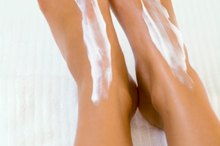Peeling Skin & Fungal Skin Infections
While few people want to shout about fungal infections, those that affect the skin seem particularly distressing. Rashes, discoloration and peeling skin may cause physical discomfort as well as embarrassment, with moisturizers and cosmetics offering little relief. Taking a closer look at the causes and effective treatments available may help you deal with this problem.
Cause
Skin infections generally occur in one of two ways 2. One cause starts with a systemic fungal infection that transmits pathogenic organisms through the bloodstream to the deeper layer of the skin. Organisms implicated in this involve candida and trichosporon. Another common method of infection sees fungal organisms like dermatophytes transmitted directly onto the skin from the external environment; dermatophytes, species that take their name from the Greek words for "skin plants," can source their energy from breaking down keratin, a protein abundant in the skin.
- Skin infections generally occur in one of two ways 2.
- Another common method of infection sees fungal organisms like dermatophytes transmitted directly onto the skin from the external environment; dermatophytes, species that take their name from the Greek words for "skin plants," can source their energy from breaking down keratin, a protein abundant in the skin.
Related symptoms
Should I Take a Probiotic Every Day?
Learn More
If your skin symptoms result from a systemic fungal infection, you will likely notice a number of other issues alongside it. Systemic infections often cause fatigue, brain fog and itchiness; most individuals with the condition experience strong cravings for foods rich in carbohydrates and sugar. Sugars represent the preferred fuel source for fungi.
- If your skin symptoms result from a systemic fungal infection, you will likely notice a number of other issues alongside it.
- Systemic infections often cause fatigue, brain fog and itchiness; most individuals with the condition experience strong cravings for foods rich in carbohydrates and sugar.
Conventional treatment
The standard response of conventional treatment typically involves topical application of an anti-inflammatory cream such as hydrocortisone. If symptoms fail to improve, then a doctor may take a swab of the skin and send it to a laboratory that checks it for fungal cultures. Upon a confirmed diagnosis, the doctor may then prescribe anti-fungal medications such as Nystatin and Diflucan. Researchers for the Oxford Journal have questioned the effectiveness of this treatment, citing fungal resistance to the drugs in question.
- The standard response of conventional treatment typically involves topical application of an anti-inflammatory cream such as hydrocortisone.
- Upon a confirmed diagnosis, the doctor may then prescribe anti-fungal medications such as Nystatin and Diflucan.
Natural treatment
How to Get Rid of Skin Fungus From Tanning Beds
Learn More
Natural treatment revolves around the use of anti-fungal foods and herbs 1. Dr Rodger Murphree, a board-certified chiropractic physician who has written five books on dealing with difficult medical problems, recommends the use of coconut oil, garlic, grapefruit seed extract and pau d'arco to help the body eradicate the troublesome organisms responsible for the infection and related symptoms 1. While Murphree recommends the inclusion of such foods in the diet, coconut oil can also be applied directly to the skin. Coconut oil contains caprylic acid, a reliable anti-fungal, which can take effect locally.
Considerations
Many individuals with a systemic fungal infection struggle to gain long-term relief from their symptoms because they fail to eradicate the organisms from the body effectively. Dr Murphree explains that a low-carbohydrate diet must be undertaken at the same time as the anti-fungal supplements and foods, as this dietary measure helps starve the problematic fungi. This move ensures that other fungi will not take the place of those killed by the use of anti-fungals.
Related Articles
References
Writer Bio
A London-based personal trainer, nutritional therapist and allergist, Marek Doyle runs Blueprintfitness.co.uk and counts world champion athletes and TV personalities amongst his clientele. He has contributed to various publications, including Good Life magazine, Natural News and PTontheNet.









